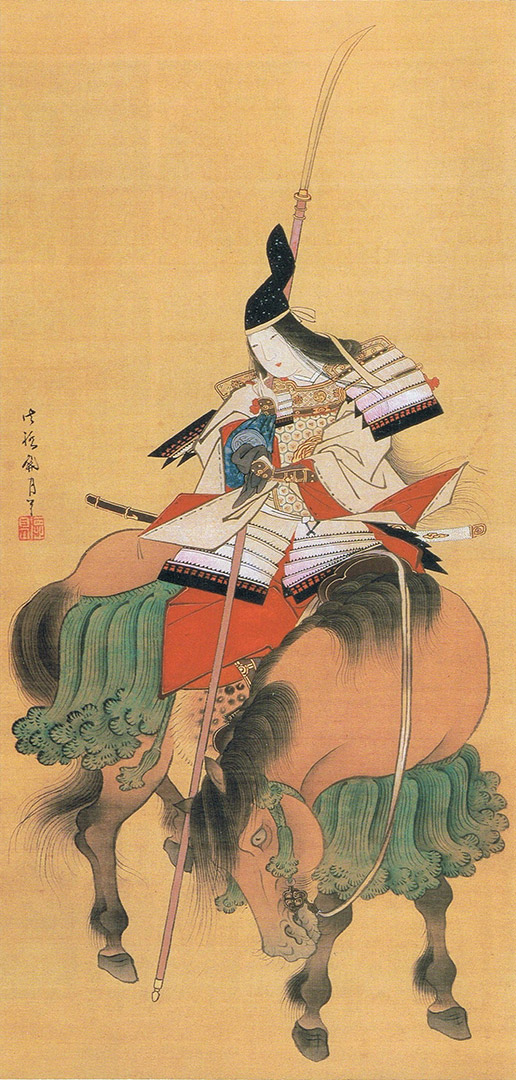Onna-bugeisha (女武芸者) was a type of female warrior belonging to the Japanese nobility. Many women engaged in battle, commonly alongside samurai men. They were members of the bushi (samurai) class in feudal Japan and were trained in the use of weapons to protect their household, family, and honour in times of war.
Long before the emergence of the renowned samurai class, Japanese fighters were highly trained to wield a sword and spear. Women learned to use naginata, kaiken, and the art of tantojutsu in battle. Such training ensured protection in communities that lacked male fighters. One such woman, later known as Empress Jingu (c. 169-269 AD), used her skills to inspire economic and social change. She was legendarily recognized as the onna bugeisha who led an invasion of Korea in 200 AD after her husband Emperor Chūai, the fourteenth emperor of Japan, was slain in battle. According to the legend, she miraculously led a Japanese conquest of Korea without shedding a drop of blood. Despite controversies surrounding her existence and her accomplishments, she was an example of the onna bugeisha in its entirety. Years after her death, Jingu was able to transcend the socioeconomic structures that were instilled in Japan. In 1881, Empress Jingū became the first woman to be featured on a Japanese banknote. Designed to stop counterfeiting, her image was printed on oblong paper.
During the earlier Heian and Kamakura periods, women who were prominent on the battlefield were the exception rather than the rule. Japanese ideals of femininity predisposed most women to powerlessness, in conflict with a female warrior role. Significant icons such as Tomoe Gozen, Nakano Takeko, and Hōjō Masako are famous examples of onna-bugeisha.
Tomoe Gozen (巴 御前) (1157–1247), was a late twelfth-century female samurai warrior, known for her bravery and strength. She fought with Minamoto no Yoshinaka in the Genpei War.
According to one historical account,
Tomoe was especially beautiful, with white skin, long hair, and charming features. She was also a remarkably strong archer, and as a swordswoman she was a warrior worth a thousand, ready to confront a demon or a god, mounted or on foot. She handled unbroken horses with superb skill; she rode unscathed down perilous descents. Whenever a battle was imminent, Yoshinaka sent her out as his first captain, equipped with strong armor, an oversized sword, and a mighty bow; and she performed more deeds of valor than any of his other warriors.— The Tale of the Heike
After defeating the Taira and driving them into the western provinces, Minamoto no Yoshinaka (Tomoe’s master) took Kyoto and desired to be the leader of the Minamoto clan. His cousin Yoritomo was prompted to crush Yoshinaka, and sent his brothers Yoshitsune and Noriyori to kill him. Yoshinaka fought Yoritomo’s forces at the Battle of Awazu on February 21, 1184, where Tomoe Gozen purportedly took at least one head of the enemy. Although Yoshinaka’s troops fought bravely, they were outnumbered and overwhelmed. When Yoshinaka was defeated there, with only a few of his soldiers standing, he told Tomoe Gozen to flee because he wanted to die with his foster brother Imai no Shiro Kanehira and he said that he would be ashamed if he died with a woman.
There are varied accounts of what followed. At the Battle of Awazu in 1184, she is known for beheading Honda no Moroshige of Musashi. She is also known for having killed Uchida Ieyoshi and for escaping capture by Hatakeyama Shigetada.
Nakano Takeko (中野 竹子, 1847 – 1868) was a Japanese female warrior of the Aizu domain, who fought and died during the Boshin War. Takeko, born in Edo, was the daughter of Nakano Heinai, an Aizu official. She was thoroughly trained in the martial and literary arts, and was adopted by her teacher Akaoka Daisuke. After working with her adoptive father as a martial arts instructor during the 1860s, Nakano entered Aizu for the first time in 1868. During the Battle of Aizu, she fought with a naginata (a Japanese polearm) and was the leader of an ad hoc corps of female combatants who fought in the battle independently, as the senior Aizu retainers did not allow them to fight as an official part of the domain’s army. This unit was later retroactively called the Women’s Army (娘子隊 Jōshitai).
While leading a charge against Imperial Japanese Army troops of the Ōgaki Domain, she was fatally shot in the chest. Rather than let the enemy capture her head as a trophy, she asked her sister, Yūko, to cut it off and have it buried. It was taken to Hōkai Temple (in modern-day Aizubange, Fukushima) and buried under a pine tree.
A monument to her was erected beside her grave at Hōkai Temple; Aizu native and Imperial Japanese Navy admiral Dewa Shigetō was involved in its construction. During the annual Aizu Autumn Festival, a group of young girls wearing hakama and white headbands take part in the procession, commemorating the actions of Takeko and her band of women fighters of the Joshigun.
Hōjō Masako (北条 政子, 1156 – August 16, 1225) was another onna-bugeisha, and the eldest daughter of Hōjō Tokimasa (the first shikken, or regent, of the Kamakura shogunate) by his wife Hōjō no Maki. She was the sister of Hōjō Yoshitoki, and was married to Minamoto no Yoritomo, the first shogun of the Kamakura period. She was also the mother of O-Hime, Minamoto no Yoriie and Minamoto no Sanetomo, the second and third shoguns. When Hōjō Masako was born in 1156, her parents were still in their teens, and she was raised by many ladies-in-waiting and nannies. Masako was born into a world of war and strife. In Kyoto, the capital of Japan, the Hōgen Rebellion was in full spring, where Cloistered Emperor Toba and Emperor Sutoku warred over who would be the next emperor. The Hōjō family wisely chose to stay out of the rebellion, even though Masako’s lineage, was descended from the Taira clan and thus was related to the imperial family. Masako was instructed in horseback riding, hunting, and fishing and she ate with men rather than with her mother, sister, and other women of the household. In 1192, Masako’s husband, Yoritomo was named Shogun by Cloistered Emperor Go-Shirakawa, who died later that year. He was then the most powerful man in Japan, and gave that power over to Masako as well. The Hōjō clan shared in that power. That same year, Masako and Yoritomo had another son, Minamoto no Sanetomo. Hōjō Masako died in 1225, at the age of 69. Due to her true example of cloistered rule, she was known as the ama-shogun, or the “nun-shogun”.



Leave A Comment